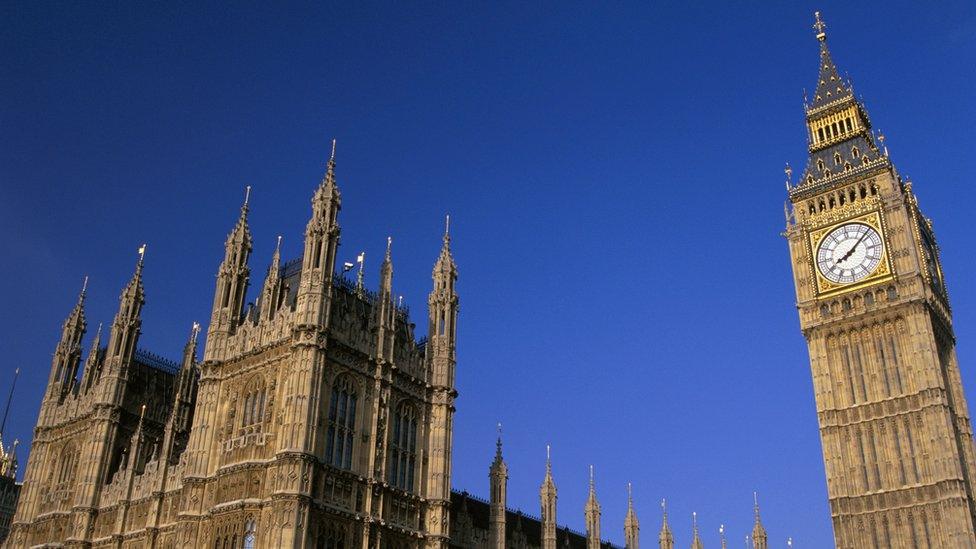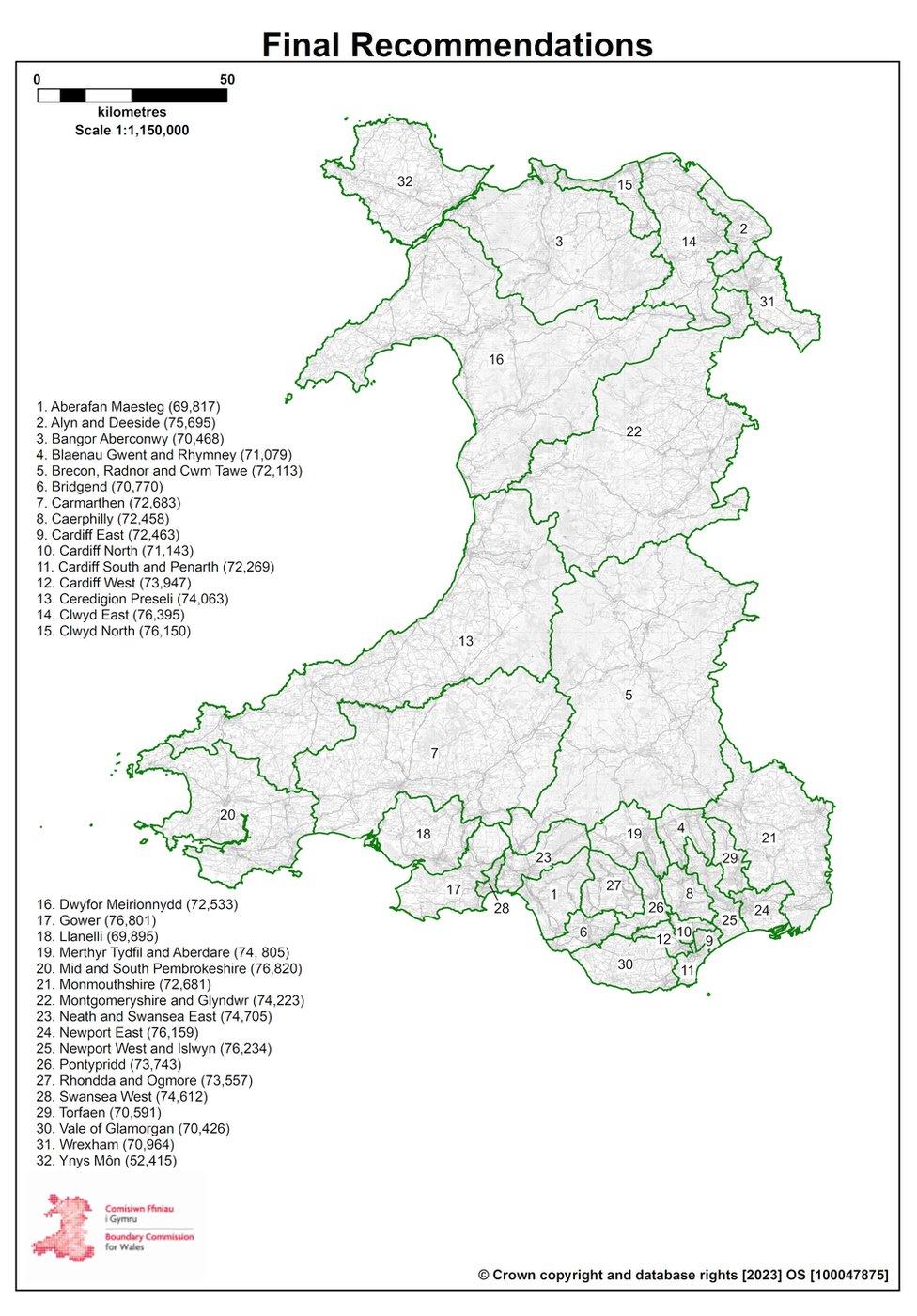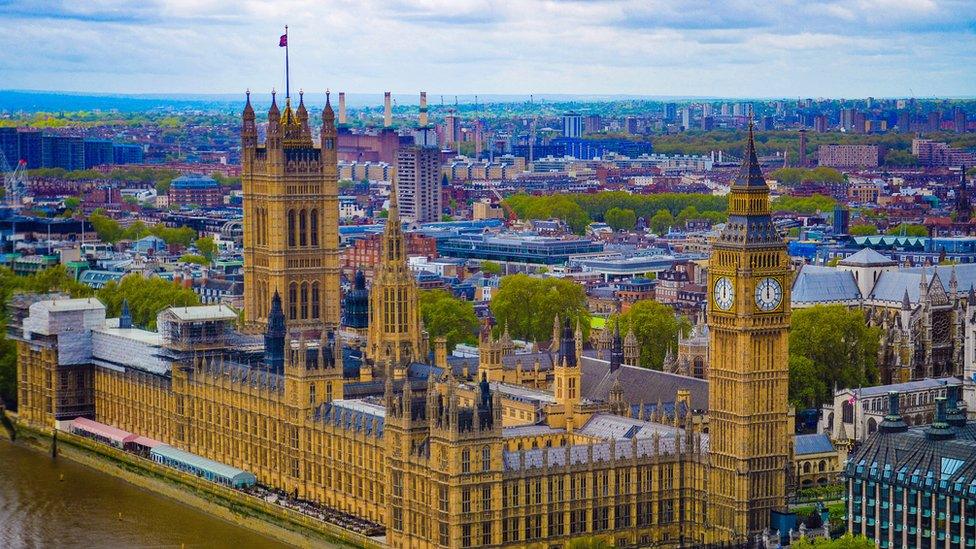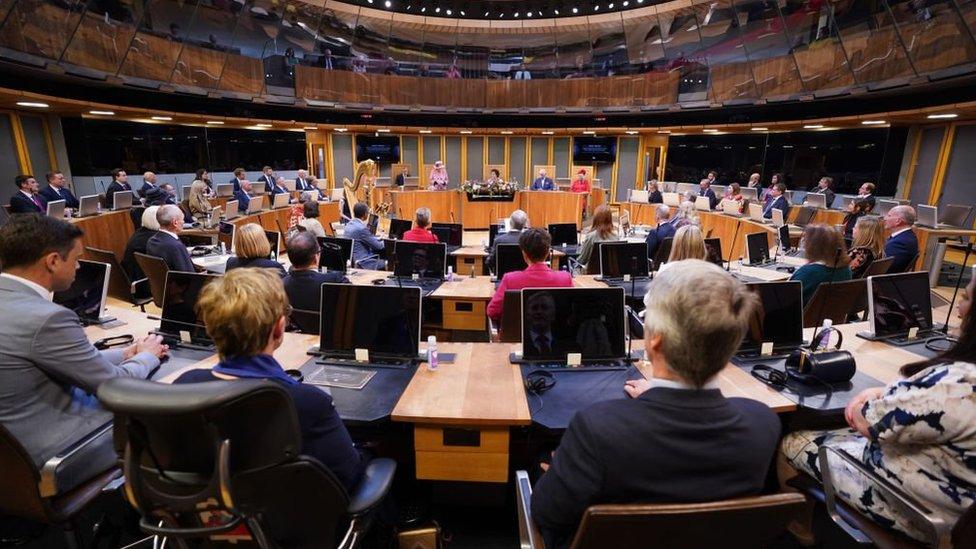Map of Welsh MPs seats redrawn as number to be cut to 32
- Published

The number of MPs representing Welsh constituencies will drop from 40 to 32
Many Westminster seats will radically change under plans to cut the number of MPs in Wales from 40 to 32.
The Boundary Commission for Wales has confirmed the shape of Westminster constituencies for the next general election.
Several Welsh seats vanish in their current form.
Two Welsh political experts say Labour is likely to be pleased with the new borders, while Conservatives may struggle to hold many of their seats.
A Labour MP said the commission had an "impossible task".
Final proposals published on Wednesday from the Boundary Commission see significant changes to plans that were previously consulted on in south Wales, including the merging of Rhondda and Ogmore valleys into a single seat.
In parts of Wales, such as the north east and south west, the political map has been redrawn almost entirely.
It all follows a earlier UK government decision to ensure each constituency has a similar number of voters in it - between 69,724 and 77,062.
Because of that Wales will lose eight seats, as the country has some of the smallest constituencies in the UK.
Reviews have taken place in each of the four nations.
It means the boundaries of all existing Welsh constituencies will be altered, with the exception of Ynys Môn, which has "protected status" and will have no changes to the island of Anglesey seat's name or boundaries.
To get to the voters required in many places the map will change substantially.
Some of the existing names for constituencies are disappearing, such as Arfon.
The plans are final and MPs cannot change them - they will take effect at the next general election, expected in 2024.

The process parties face in selecting for the new seats has the potential to cause rows - one sitting Labour MP, Beth Winter, has lost out to frontbench colleague Gerald Jones in a selection for a one of the new constituencies.
The new map will form the basis for the larger 96-member Senedd, with the Welsh Parliament creating 16 constituencies which will be served by six MSs each.
Under the plans the new Senedd constituencies will be paired combinations of the 32 set out for Westminster.
Labour MP for Rhondda Chris Bryant said: "The Rhondda and Ogmore Valleys have a lot in common - not least a mountain in between. And many people in Tonyrefail and Gilfach Goch feel they live in the Rhondda."
But he said he was "surprised that the boundary proposals have changed three times now, including at this very last stage, especially with a seat that straddles two local authorities.
"I fear the government gave the Boundary Commission an impossible task."
A Plaid Cymru spokesperson said it was "unacceptable that Wales faces a 20% reduction in our democratic voice" and the Boundary Commission had faced a "difficult task".
"However, we're confident under these new constituencies of returning a strong group of Plaid Cymru MPs to hold the Westminster parties to account."
"Combining post-industrial communities like Cwm Tawe with rural areas like Brecon and Radnor is nonsensical and exposes the absurdity of limitations imposed by Westminster," the spokesperson added.

What could it mean for the parties?
Ed Gareth Poole and James Griffiths, Cardiff University
Because of the scale of these changes, any projections about this means for the electoral map are completely tentative.
We do not know how parts of a constituency votes at Westminster elections, so our best guide is to examine ward-level voting in council elections.
Labour
Although the reduction in Welsh MPs from 40 to 32 will dent the party's overall numbers at Westminster, Labour will likely be rather pleased with the current map, all things considered.
The boundary changes are unlikely to undermine their dominance in the southern valleys and cities, and no Labour seat is threatened.
The final proposals also iron out several boundary quirks in the interim proposals in the Swansea and Bridgend areas.
The Vale of Glamorgan seat loses leafy Dinas Powys to (safe Labour) Cardiff South & Penarth - meaning that Alun Cairns' seat will again be a top Labour target.
Conservatives
If current opinion polls are any guide, the new map means that the Conservatives will struggle to retain many of their seats next year.
Seats where the Conservatives start as incumbents include Mid and South Pembrokeshire, Monmouthshire, and Montgomeryshire & Glyndŵr.
But all of these include new areas that are favourable to Labour, such as the addition of Caldicot to David TC Davies' Monmouth seat.
One piece of favourable news for the party in the final proposals is that Bridgend and Porthcawl remain in the same constituency. In the interim proposals, the Conservative-held Bridgend seat had been split in two, with Porthcawl linked to Aberafan.
The north - where the Conservatives picked up six seats in 2019 - has changed beyond recognition. Tory-held seats here seats should be expected to follow Conservative fortunes in the "red wall" of northern England.
Plaid Cymru
The stark reduction of seats in the north and west will make Plaid Cymru uneasy about the impact of the changes on their four current seats.
The party should feel reasonably confident about retaining Ceredigion Preseli, while Dwyfor Meirionnydd becomes a rock-solid Plaid seat with the addition of Caernarfon and Y Felinheli.
There portends to be a "battle royale" at the new seat of Caerfyrddin which covers all northern Carmarthenshire. Plaid will face new competition from the Conservatives in the Whitland area and Labour in Carmarthen town.
Liberal Democrats
The party's most competitive prospect is probably in Brecon, Radnor and Cwm-Tawe.
Cwm-Tawe adds in areas that should be "heavy-sledding" for the Conservatives. Although Pontardawe is a Labour-Plaid area, heavy tactical voting may help the Liberal Democrats.
What are the changes?
David Deans, BBC Wales
Mid and west Wales
The rural seat of Brecon and Radnorshire will be expanded to parts of the existing Neath constituency, in the Swansea Valley, including Ystalyfera and Pontardawe. The new seat will be called Brecon, Radnor and Cwm-Tawe.
The two existing Pembrokeshire constituencies will be scrapped. A new seat, called Mid and South Pembrokeshire, will cover Milford Haven, Pembroke Dock, Tenby and Haverfordwest.
Ceredigion will be extended out west to include parts of Fishguard, in a seat called Ceredigion Preseli.
Carmarthen town and surrounding suburbs - currently split across two seats - will be united under one large rural constituency, called Caerfyrddin, the Welsh name for the town.
Montgomeryshire will be combined with council wards from part of Clwyd South, including Chirk North and South and Penycae, to form Montgomeryshire and Glyndŵr.
South east Wales
Monmouth will be renamed Monmouthshire - including more of the Severnside area including the town of Caldicot.
Newport will still have a Newport East constituency, although it will incorporate parts of what is currently in Newport West.
The rest of the latter seat will be in a constituency called Newport West and Islwyn which will include much of the valley extended west from the city.
A slightly-expanded constituency called Torfaen will remain, including parts of Cwmbran that are currently in Monmouth.
Blaenau Gwent will be extended to cover areas in the Rhymney valley, which is currently in the Merthyr Tydfil seat.
A seat called Caerphilly will remain with revised boundaries, and a small part of the Islwyn constituency.
Cardiff and the Vale
The existing seat of Cardiff Central will be scrapped.
A new seat called Cardiff East will include part of the old constituency, and a bit of what was Cardiff South and Penarth.
The new Cardiff South and Penarth seat will extend all the way from Penarth to a small part of the inner city - Cathays - and will include Dinas Powys in the Vale of Glamorgan for the first time. An amended Vale of Glamorgan seat will still exist.
A Cardiff West seat will remain, including a small part of the Pontypridd seat.
The central valleys & Bridgend
The final proposals see significant changes from what the commission previously had planned.
Porthcawl and Pencoed will now be included in the constituency of Bridgend, following opposition to tie it up with the Port Talbot seat of Aberafan.
Because of the decision on Bridgend, the Rhondda and Ogmore valleys will be combined into a Rhondda and Ogmore constituency.
The seat of Cynon Valley will disappear in the changes, split between the seats of Merthyr Tydfil and Aberdare, and Pontypridd.
The new Pontypridd seat will include much of the old one, including the town itself and Talbot Green, as well as three wards from the current Ogmore seat including Llanharan.
Swansea and the south west
The changes above also have a knock on effect for the planned seat of Aberafan, which instead of including the area around Porthcawl will be merged with Maesteg, to form the Aberafan Maesteg seat.
The seat includes the areas of Port Talbot and Baglan.
It will not include Skewen as originally planned, meaning significant changes to the constituencies in Swansea and Neath.
The town will be combined instead with Neath and Swansea East, which will include most of the existing seat of Neath and three wards from Swansea East, including Llansamlet.
The Gower constituency will include all but one of the council wards of the existing seat of the same name, plus five wards from the existing Swansea West seat including Killay.
Swansea West is formed from what is left of Swansea West - Castle, Sketty, Townhill and Uplands - and parts of Swansea East.
The town of Llanelli will still have a seat named after it, including four wards from Carmarthen East and Dinefwr.
North west Wales
Because of its protected status Ynys Môn - which covers Anglesey - will remain a standalone constituency.
The constituency of Arfon will cease to exist.
Part, including Caernarfon and Llanberis, will join Dwyfor Meirionnydd.
Part of Arfon, including wards that cover the city of Bangor, and some areas in Clwyd West such as Llansannan, will merge with Aberconwy to form Bangor Aberconwy.
North east Wales
The seats of Delyn, Clwyd West, Clwyd South and Vale of Clwyd vanish in the new map.
Much of that constituency, including Mold, Gronant and New Brighton, will form the new Clwyd East. The new seat will include Prestatyn from Vale of Clwyd, Llangollen from Clwyd South and Ruthin from Clwyd West.
Rhyl, Bodelwyddan, Denbigh and St Asaph from Vale of Clwyd will be joined together parts of Clwyd West including Colwyn and Towyn, to form Clwyd North.
A constituency will still exist called Alyn and Deeside, including the whole of the existing consistency, but with wards from Delyn including Flint and Bagillt.
Wrexham will be expanded to take more of the council area, including New Broughton and Overton.
Related topics
- Published28 June 2023

- Published10 May 2022
